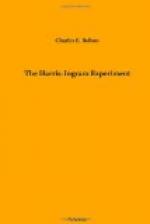Dr. Argyle said, “Judge, what do you think of novels anyway?”
The matter-of-fact judge gruffly replied, “I never read the modern novel because I don’t care to waste my time.”
Whereupon Alfonso said, “Give me the novel of an idealist that has a purpose. Colonel Ingersol spoke the truth in a recent lecture when he said that a realist can be no more than an imitator or a copyist. His philosophy makes the wax that receives and retains an image of an artist. Realism degrades and impoverishes. The real sustains the same relation to ideal that a stone does to a statue, or that paint does to a painting.”
“No,” replied Leo, “a novel proper should be a love story spiced with the beauties of nature and exciting adventures. A novel with a purpose, Alfonso, should advertise under another name for it is a cheat. It is often written with a deliberate attempt to beguile a person into reading a story which the writer deliberately planned to be simply the medium of conveying useful or useless information. Possibly a social panacea, or the theme may include any subject from separating gold from the ocean, to proving the validity of the latest theory on electricity.”
“Leo, you go too far,” said Mrs. Harris, “the modern novel that appears in press and magazine, and later in book form, entering all our homes, should teach high morality and contain only proper scenes and passages.”
“But, mother,” said Lucille, “you would thus debar many of the world’s masterpieces in literature. It seems to me that the morality of character and scene has little to do with the artistic value of the book. The realist must depict life as it is. ‘Art, for art’s sake,’ is what commends a novel to artistic minds.”
“The modern novel is too much like modern architecture,” said the judge, “a combination of classical and subsequent styles thrown together to satisfy groups of individuals rather than to conform to well accepted rules or ideas of art. Modern novels and modern architecture are sure to give way to nobler thoughts that shall practically harmonize the useful and the beautiful.”
Dr. Argyle, having asked for opinions on the modern novel, obtained them. He was an earnest listener as he had wished more knowledge of the Harris family, which would enable him the better to lay plans; he hoped to win Lucille’s favor.
It was now a quarter to six o’clock and many passengers, including the Harris group, moved to the port side of the ship to observe if the sun, at the expiration of twelve hours, would again touch the water. This twenty-first day of the month had been one of Lowell’s rare June days. It had been ushered in by beautiful cloud coloring.
The ocean was now free from mist, the blue clouds overhead darkened the sea to the horizon, and it looked as if the sun would set behind clouds. Unexpectedly, however, the clouds near the water separated, and the sun again appeared in all his glory, sending a weird light out over the water, gilding the “Majestic,” flooding the faces of the passengers with an unnatural light, and bringing into strong relief a sailing craft hovering on the starboard horizon.




